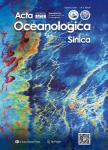Striking taxonomic differences in summer zooplankton in the northern South China Sea: implication of an extreme cold anomaly
Striking taxonomic differences in summer zooplankton in the northern South China Sea: implication of an extreme cold anomaly作者机构:Key Laboratory of Marine Bio-resource Sustainable Utilization (LMB) South China Sea Institute of OceanologyChinese Academy of Sciences
出 版 物:《Acta Oceanologica Sinica》 (海洋学报(英文版))
年 卷 期:2017年第36卷第10期
页 面:87-96页
核心收录:
学科分类:0710[理学-生物学] 0908[农学-水产] 07[理学] 0707[理学-海洋科学] 0713[理学-生态学]
基 金:The National Natural Science Foundation of China under contract Nos 41506161 and 41276162 the National Basic Research Program(973 Program)of China under contract No.2015CB452903 the Strategic Priority Research Program of the Chinese Academy of Sciences under contract No.XDA11020305 the Special Fund for Agro-scientific Research in the Public Interest under contract No.201403008
主 题:zooplankton community cold anomaly northern South China Sea
摘 要:An extreme persistent cold anomaly was prevailing in the South China Sea in February 2008. In order to understand the effect of the cold anomaly on zooplankton community, the zooplankton composition, abundance and biomass were analyzed in the northern South China Sea in August 2007 and August 2008. A total of 467 zooplankton species representing 16 groups were identified, with 275 species in August 2007 and 351 in August2008. Copepods were the most dominant zooplankton group in the study area. Compared with 2007, a dramatic decline was observed in the abundance of four dominant copepod species: Subeucalanus subcrassus, Temora discaudata, Nannocalanus minor and Temora turbinata in 2008. Moreover, zooplankton abundance declined from 133.37 ind./m^3 in August 2007 to 75.49 ind./m^3 in August 2008. In contrast, the abundance of medusa, such as Diphyes chamissonis, and tunicate, such as Doliolum denticulatum and Dolioletta gegenbauri, increased during the same season. Cluster analysis showed that there was a difference in zooplankton community structure between the two years. These variations in zooplankton communities were indicative of an anomalous oceanographic condition along with the extreme cold event in 2008.



